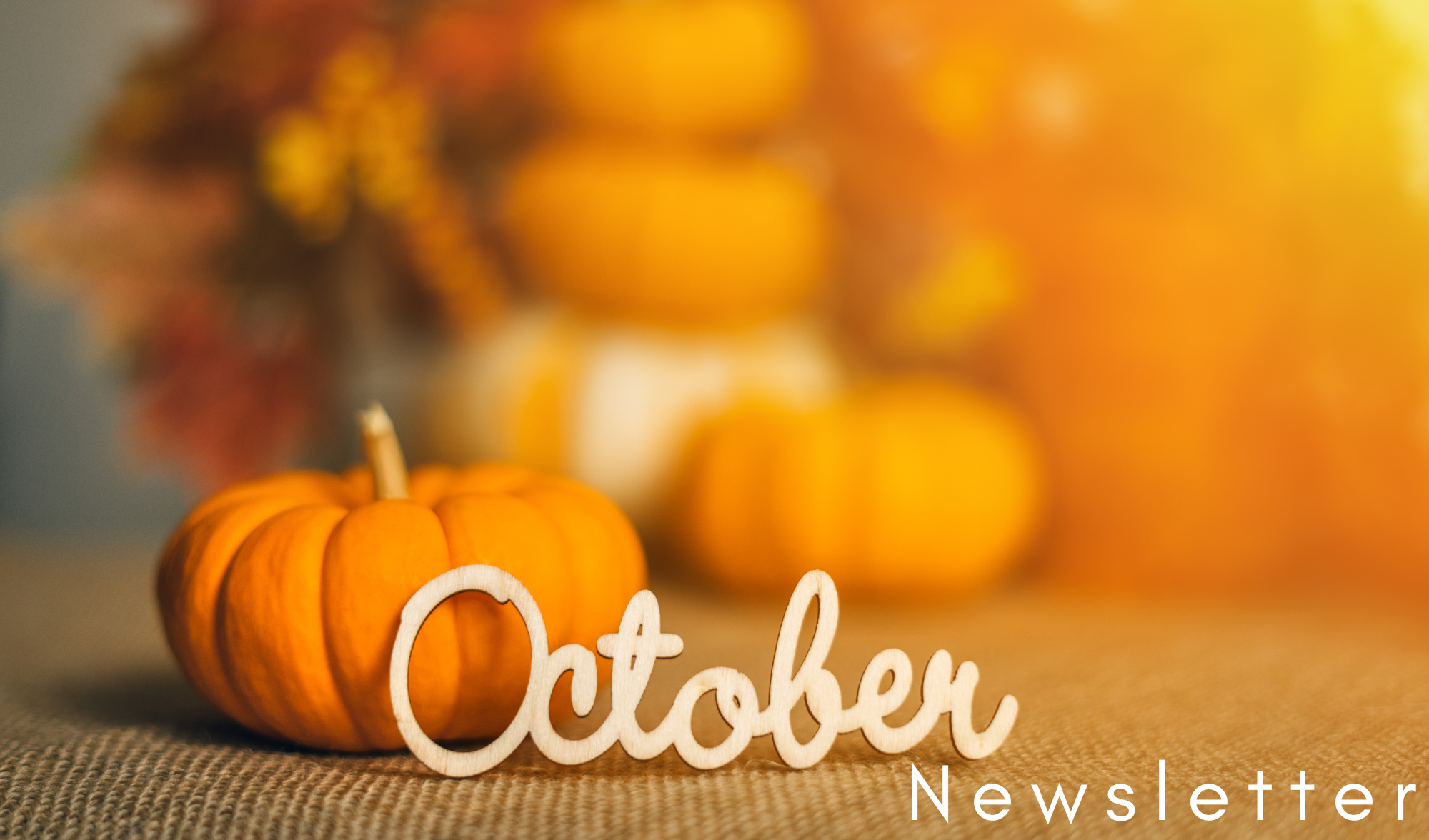October Newsletter
We hope you're enjoying the gorgeous changing leaves, the crisp fall weather, and the pumpkin spice everything. Speaking of pumpkin, if you need a little more in your life, check out the 5 fall recipes we've included below (spoiler alert: they all feature pumpkin). And before you pick up the rake, read the article on why you might want to skip leaf removal this year. You'll also find some bathroom remodel tips for DIYers and a quick update on the national housing market.
Enjoy, and thank you for reading!
-Katie, Olga and Teresa
What’s not to love about pumpkins? They’re cute and round and orange, you can carve them or paint them for Halloween, and they’re a delicious and healthy food. (One can of pumpkin puree contains 200% of your daily vitamin A, a decent amount of fiber, and powerful antioxidants.) So stock up on pumpkin the next time you hit the grocery store so you can try out these recipes!
3-Ingredient Pumpkin Chocolate Chip Cookies (SugarHero)
If you need something quick, easy, and oh-so-tasty, these pumpkin chocolate chip cookies are perfect! The only ingredients are a box of cake mix, a bag of chocolate chips, and a can of pumpkin puree. The cookies will be soft, cakey, and packed with pumpkin flavor.
Turkey Pumpkin White Bean Chili (Skinnytaste)
The quintessential fall comfort food gets even cozier with the addition of—you guessed it—pumpkin. This recipe can be prepared using a slow cooker or Instant Pot, and you can adjust the spiciness to your preference.
Coconut Pumpkin Curry (Recipe Tin Eats)
This easy and flavorful homemade dish consists of a creamy coconut-tomato sauce, lentils, cubed pumpkin, baby spinach, and cashew nuts. What a delicious way to warm up on a cool autumn day!
Homemade Pumpkin Butter (Minimalist Baker)
Your morning toast just met its new best friend. Pumpkin butter is a fall staple that belongs in every pumpkin-lover’s kitchen. This recipe takes only 20-30 minutes on the stovetop, and it keeps for 2 weeks in the refrigerator.
Spiced Pumpkin Yogurt Parfaits (Cookin’ Canuck)
Start your day off right by preparing this pumpkiny parfait for breakfast. There’s no cooking necessary—just stir together the pumpkin mixture and layer it in a glass with protein-packed Greek yogurt and your favorite granola.
Kicking back with some popcorn and Halloween candy to watch a scary movie is fun. But watching your DIY bathroom remodel turn into a horror show? Not so fun.
Follow this advice from Architectural Digest and Bob Vila to make sure you achieve the bathroom of your dreams
1. Start with a detailed plan and precise measurements.
While it's tempting to jump right into shopping for faucets and picking out tile samples, you shouldn't make any final decisions until you've measured everything, sketched out the floorplan, researched different types of materials, and estimated costs. Wait until you've planned out the entire bathroom, then start shopping. The end result will be a cohesive look and feel, rather than something haphazardly cobbled together.
2. Choose materials designed to withstand humidity and moisture.
Engineered quartz and laminate are good choices for countertops; sheet vinyl is the most durable for flooring; and if you opt for tile, be sure to use water-repelling grout. Do some research to find the best materials for your bathroom!
3. Leave plumbing work to the professionals.
If any plumbing work will be involved in your remodel, don't DIY it. It's not just that you might mess up and flood your bathroom—it's also a matter of safety. "Attempting to move or relocate plumbing pipes or drains is serious business as sewer gasses need to be vented correctly in order to prevent inadvertent poisoning," says interior designer Charmaine Wynter.
4. Allow for some wiggle room in your budget.
Whatever you think it's going to cost, go ahead and add an extra 15-20%. You never know what surprises you might unearth as you begin to pull up old flooring and remove dated fixtures.
5. Fix the small mistakes right away.
Chances are, you're going to make some mistakes. Laying your own tile, for instance, is meticulous work. So when you mess up—even just a little bit—go ahead and make it right. Otherwise, that crooked tile is going to haunt you for the rest of your life.
Fall is here, which means those gorgeous changing leaves will soon be tumbling down to cover your lawn. Time to dust off the old rake and get to work.
Or is it?
Do you have to rake up all of those leaves?
Should you?
Most people rake leaves because they want to keep their lawn healthy and tidy. After all, a dense layer of leaves will block out the sunlight, causing certain types of grass to wither and die. But NOT raking leaves also provides benefits to the health of your lawn—and to the environment.
Benefits of NOT raking leaves:
Fallen leaves are a natural fertilizer. “When leaves break down where they fall, they return essential nutrients to the grass and soil,” writes landscaping expert David Beaulie for The Spruce. “Additionally, the coverage that the leaves provide preserves soil moisture and suppresses weeds.”
Leaf litter provides a home to caterpillars over the winter months. Let the leaves stay, and you’ll boost the butterfly population in your yard.
By promoting a healthy insect population, you'll also aid the bird population. The insects in your yard are nutritious food for birds and their offspring.
So, should you rake or not?
If your lawn depends on autumn sunlight, you can’t just ignore the fallen leaves—especially if there’s a lot. But if you still want to reap the benefits of leaves as a natural fertilizer, there is another option: instead of raking and removing the leaves, use your lawnmower to chop them up into mulch. The smaller pieces won’t block the sun and they will break down faster, speeding up the natural fertilizing process.
Depending on how many leaves fall in your yard, you might need to mow over them once a week. And if you have some areas of your yard where you can just leave the leaves alone—grassless areas like flower beds—go for it. Let those intact fallen leaves provide shelter to future butterflies and food for birds.
If you do decide to remove leaves from your lawn, don’t let them end up in landfills. Never bag them up in plastic bags and set them out with the garbage. Instead, look up your city’s leaf collection services and plan your raking accordingly. Most cities will come by on scheduled days to collect leaves, which will then be recycled into compost by the city (and sometimes the resulting compost is even offered to residents free of charge). If you are required to bag your leaves, only use brown paper biodegradable bags.
National Housing Market Update
Home affordability continues to be a challenge for buyers, but there's good news: prices have dropped in 98 major regional US markets.
This is a surprise for many people, because price drops typically occur when supply levels skyrocket—and in these markets, the supply levels are remaining about the same. So what is driving the price correction trend?
It seems that after two years of pandemic-driven price appreciation (prices are 43% higher today than pre-Covid) and this year's skyrocketing mortgage rates (from ~3% in January to ~6% today for a 30-year fixed), the buyer end of the market is pushing back.
“The longer that [mortgage] rates stay elevated, our view is that housing is going to continue to feel it and have this reset mode. And the affordability resetting mechanism right now that has to happen is on [home] prices. And so there are a lot of markets across the country where we’re forecasting that home prices are going to fall double-digits,” said Rick Palacios Jr., head of research at John Burns Real Estate Consulting.
Palacios predicts that we'll continue to see prices drop in 2023 and 2024.





